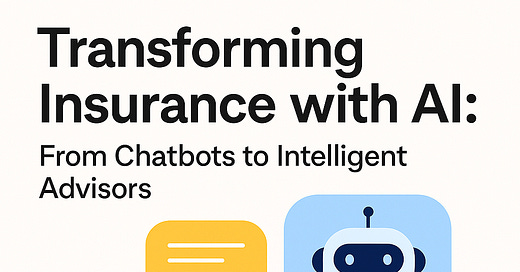Transforming Insurance with AI: From Chatbots to Intelligent Advisors
AI-Powered Assistants That Actually Understand Customers: From FAQ Assistants to Intelligent Product Advisors
As generative AI and large language models (LLMs) evolve, a new frontier opens for the insurance industry: the intelligent conversational assistant.
We're not talking about simple FAQ bots or lead capture —we’re envisioning AI systems that understand context, recommend insurance products based on the customer’s history and profile, and go even further by initiating quotes and issuing policies within the same conversational interface.
This vision is not just about automation. It's about delivering personalized value, enhancing customer engagement, and creating an experience that mirrors a real interaction with a seasoned human advisor—but faster, smarter, and always available.
What if Chatbots Could Truly Advise?
What if, instead of offering generic menus or keyword-matched responses, an AI assistant could truly understand a customer’s profile, context, needs, their personal history, and even the insurance products they already hold—and recommend the most suitable options accordingly?
This isn’t just an upgrade. It’s a game changer.
Utilizing generative AI and integration tools like RAG and Tools to deliver an intelligent assistant that recommends, quotes, and issues policies in real time—within a natural conversation—is a strategic leap forward.
This approach brings value both to the insurer and the client, increasing satisfaction, conversion rates, and brand loyalty.
What Are Insurance Companies Doing Around the World?
Lemonade (USA & UK)
Their AI-powered claim bot “Jim” can approve simple claims in 2–3 seconds.
Over 30% of claims are processed without human intervention.
Ranked #1 in customer satisfaction (NPS +70).
However, Lemonade’s chatbot technology is primarily focused on claims processing and not on personalized product recommendations or end-to-end quoting and policy issuance via chatbot.
Ping An (China)
The “111 Fast Claim” service enables real-time policy issuance and claim settlement in under 8 minutes.
AI is used to dynamically adjust premiums based on health data and behavior.
However, these innovations are geared toward pricing and operational efficiency rather than product recommendation and conversational insurance sales.
EagleX — Ping An
Uses AI to assess natural disaster risks and produce geographic risk maps.
Still, it is a climate-risk mitigation solution, not a chatbot for personalized product recommendations or transactional sales.
And in Latin America?
In Latin America, most chatbot deployments in insurance are still focused on servicing: answering FAQs, providing documents, and initiating claims. The use of LLM-powered assistants for recommending products, quoting, and issuing policies based on customer profiles remains largely unexplored.
However, companies like SURA, Mapfre, and Porto Seguro have been piloting AI use cases, particularly in fraud detection, claims automation, and lead qualification. The next step—intelligent, transaction-ready conversational sales—has yet to be embraced at scale.
A New Paradigm for Insurance Chatbots
The next generation of intelligent assistants must go beyond scripted flows. They must:
Understand the customer’s profile, context, and insurance history.
Recommend tailored products that match the client's unique needs.
Initiate a quote.
Call APIs.
Trigger workflows.
Issue a policy.
All this, in the context of a seamless, human-like conversation.
This evolution turns the chatbot from a passive responder into a proactive advisor and transactional agent—deeply integrated into the insurer’s digital ecosystem.
A Technical Leap Forward: Building an Intelligent Recommender
On Medium, I’m publishing a hands-on article series on how to build this kind of advanced AI chatbot using:
Java 24 + Spring Boot 3.5.0
Langchain4j 1.0.1
OpenAI (GPT-4o & embeddings)
pgvector + PostgreSQL 17
WebSocket for real-time communication
React/Angular frontend
And full integration with core insurance systems via REST APIs.
👉 Latest article (Part 3):
Build an AI Chatbot with Java (Part 3): Using a Persistent Embedding Store with PostgreSQL 17 + PGVector
This article introduces the concept of RAG (Retrieval-Augmented Generation) and persistent vector stores, where insurance products are semantically indexed based on descriptions, coverages, and—critically—target audiences.
By embedding this data, the chatbot can match a customer's profile to the right insurance products, enabling context-aware recommendations, not static menus.
Real Innovation: Semantic Matching via Target Audience
Each insurance product in the knowledge base is enriched with a clear “Target Audience” description (e.g., young professionals, parents with dependents, travelers). This is a key breakthrough.
Combined with Langchain4j’s semantic search and vector matching capabilities, it allows our assistant to respond like this:
“Based on what you told me, I recommend our Health Insurance plan for families and the Personal Accident plan tailored to professionals with high travel exposure.”
That’s intelligence. That’s personalization.
From Demo to Digital Platform: What’s Next?
So far, we’ve covered how to build the backend brain. But we’re just getting started.
In the upcoming parts of the series (in Medium), we’ll:
Build a real-time chatbot using WebSocket.
Integrate a frontend in React or Angular.
Create quoting flows with real-time price generation.
Use Langchain4j Tools to trigger backend API actions (e.g.,
createQuote()orissuePolicy()).Seamlessly connect to core insurance platforms via REST APIs.
We’re building a full-stack, conversational sales engine ready for enterprise deployment.
Final Thoughts
The convergence of generative AI, semantic search, and tooling is opening incredible opportunities for the insurance industry.
The future belongs to smart, integrated, and context-aware chatbots—ones that:
Understand who your customer is.
Recommend what they actually need.
Quote it.
And even issue it.
This is more than digital transformation. This is reinventing the way insurance is bought and sold.
About the author
Rodrigo López Gatica is Director of Architecture at Kopernicus Tech (lopez.rodrigo@kopernicus.tech), specializing in designing modern solution architectures and implementing insurance core systems.
Follow me in Medium: https://medium.com/@rodrigo.lopez.gatica



